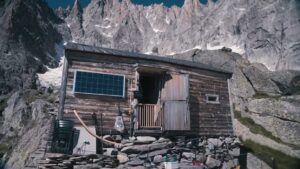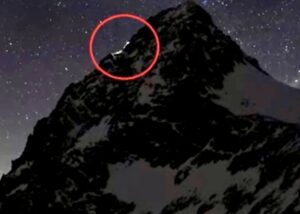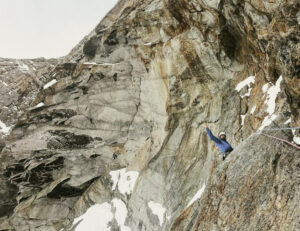New lines or first winter ascents are coming almost daily in the Alps. Novelties occur on even old standards like the Matterhorn and the Grandes Jorasses. Why is this winter so different?
Is it because there are more climbers or better conditions? According to Francois Cazzanelli, it may be something else.
We spoke to the Italian at a rare moment when he was not climbing. Instead, Cazzanelli was on duty at the mountain rescue post in Cervinia. The radio crackled on the desk beside him as we spoke. Our interview would end abruptly the moment an SOS call came. Fortunately, we chatted without drama.
Hectic season
“There was a long spell of good weather, with two weeks of high pressure that kept skies blue,” Cazzanelli said. “Conditions were great for climbing. Not everywhere, because there is little snow, but excellent on some faces [mainly the rock/mixed routes]. In the last few weeks, I’ve managed to chain-climb several projects I had in mind. I have made the best out of the good conditions. However, there was a lot to do in previous winters, too.”

Left to right: Cazzanelli, Stradellin, and Favre at Aosta Valley earlier this winter. Photo: Francois Cazzanelli
Cazzanelli also believes that winter climbing is increasing because climate change has affected conditions in the mountains during the summer.
“We’re at the end of February but conditions look like those in a typical April. It’s like fast-forwarding two months,” he said. “We [the mountain guides] are seriously concerned about the upcoming summer.”
Cazzanelli also suggests that rather than more climbs, there may simply be more audience interest in what top climbers are doing in the Alps.
What makes the news
At the same time, most of this audience fails to understand the difference between alpinism and tourism, says Cazzanelli.
“Some people put their 8,000m summit photo on Instagram and it is perceived as big news. In my professional career, I have kept a balance between my activities in the Alps and in the Himalaya. The merit of a climb is not about the altitude. Basically, climbing with Sherpas and oxygen is high-altitude tourism, similar to climbing Mont Blanc with a guide.”
 Francois Cazzanelli with Jerome Perruquet and Petro Ricco on the summit of K2. Photo: Francois Cazzanelli
Francois Cazzanelli with Jerome Perruquet and Petro Ricco on the summit of K2. Photo: Francois Cazzanelli
He adds that mainstream media is not the real problem. “The problem is when specialized media highlights certain influential characters as top alpinists when they are not.”
At least, the attention paid to the Alps this winter is justified: There were many top climbs done in a pure style.
Cazzanelli admits that after his experience in Pakistan last summer (he climbed Nanga Parbat and K2 without oxygen), his motivation to climb normal routes on other 8,000’ers in peak season is “rather low.”
“Yeah, I climbed without O2. A good performance, but nothing new. I intend to return to Pakistan in the summer with Matteo della Bordella [currently in Patagonia], but not to an 8,000’er, not on a normal route, not among the crowds.”
Looking for inspiration
What does Cazzanelli look for when considering new projects?

Marco Farina climbing on Cervino’s south face. Photo: F. Cazzanelli
Novel ideas seem easier for him to find in hidden Himalayan valleys than in the familiar Alps, where Cazzanelli was born and grew up in a family of mountain guides. He climbed the Matterhorn for the first time at 13 with his father, Walter Cazzanelli.
Cazzanelli has gone on to climb the mountain 97 times, most recently last week. Together with Marco Farina, he climbed the 1,600m-long Benedetti-Carrel route, on the south side of the peak. It took him 4 hours and 35 minutes from base to summit.
“For me, becoming a guide and rescuer was only natural. Not to continue a family tradition or because of destiny. It’s just that I am happy when I am in the mountains. I love to combine my time there, climbing for myself, guiding others, teaching, or helping with rescues.”
Knowing the place so well, one might think the new challenges could soon run out. “Not at all,” Cazzanelli said. “The Alps are full of opportunities for new climbing projects and always will be, as long as climbers keep their imaginations working.”
Brotherhood of the rope
After inspiration, the most important part of climbing for Cazzanelli is the team.
Cazzanelli is one of a group of remarkable young climbers who are stirring the alpine-style scene with prolific activity. Cazzanelli has his regular climbing partners in Aosta (where he was born) and Cervinia (where he lives). Yet he is open to new partners.
“I would climb with Charles Dubouloz, whom I find very inspiring,” he said. “I’d like to climb with Denis Urubko because I met him last summer in the Karakoram and I think he is a super good guy. Also, I want to climb with Tom Livingstone. I like his pure, highly ethical style.”

Cervino (Matterhorn) summit picture. Cazzanelli clings to the summit cross. Photo: Marco Farina
Often, he finds both friends and inspiration through social media. He spends a lot of time and effort maintaining his online presence.
“Properly used, social media is great for communication. Now it is extremely easy to find out what other climbers do, which is a good starting point both for getting in touch with them and also to inspire each other…I guess we are the Instagram climbing generation, but hey, in the good sense!”






